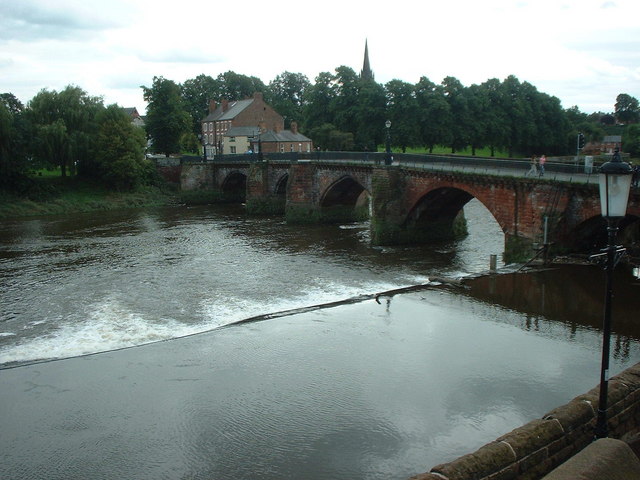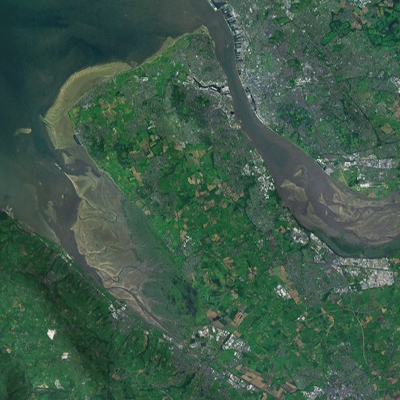|
Chester Weir
Chester Weir is a weir which crosses the River Dee at Chester, Cheshire, England, slightly upstream from the Old Dee Bridge (). The weir and the associated salmon leap are recorded in the National Heritage List for England as a designated Grade I listed building. This was originally the site of a causeway across the River Dee. The weir was built in sandstone in 1093 for Hugh Lupus, 1st Earl of Chester, for the Benedictine Abbey of St Werburgh (now Chester Cathedral). It was designed to provide a head of water for the medieval mills on the river. The mills were demolished during the 20th century and the weir was restored to serve the Chester City Council's hydro-electric power station, which operated from 1913 to 1939 on the site of the former mills. The weir continues to provide three essential roles in maintaining the very substantial water abstractions from the River Dee. It prevents tidal water ingress up-river for all but the highest tides; it provides the w ... [...More Info...] [...Related Items...] OR: [Wikipedia] [Google] [Baidu] |
Chester City Council
Chester is a cathedral city and the county town of Cheshire, England. It is located on the River Dee, close to the English–Welsh border. With a population of 79,645 in 2011,"2011 Census results: People and Population Profile: Chester Locality"; downloaded froCheshire West and Chester: Population Profiles, 17 May 2019 it is the most populous settlement of Cheshire West and Chester (a unitary authority which had a population of 329,608 in 2011) and serves as its administrative headquarters. It is also the historic county town of Cheshire and the second-largest settlement in Cheshire after Warrington. Chester was founded in 79 AD as a "castrum" or Roman fort with the name Deva Victrix during the reign of Emperor Vespasian. One of the main army camps in Roman Britain, Deva later became a major civilian settlement. In 689, King Æthelred of Mercia founded the Minster Church of West Mercia, which later became Chester's first cathedral, and the Angles extended and strengthened ... [...More Info...] [...Related Items...] OR: [Wikipedia] [Google] [Baidu] |
Weirs In England
A weir or low head dam is a barrier across the width of a river that alters the flow characteristics of water and usually results in a change in the height of the river level. Weirs are also used to control the flow of water for outlets of lakes, ponds, and reservoirs. There are many weir designs, but commonly water flows freely over the top of the weir crest before cascading down to a lower level. Etymology There is no single definition as to what constitutes a weir and one English dictionary simply defines a weir as a small dam, likely originating from Middle English ''were'', Old English ''wer'', derivative of root of ''werian,'' meaning "to defend, dam". Function Commonly, weirs are used to prevent flooding, measure water discharge, and help render rivers more navigable by boat. In some locations, the terms dam and weir are synonymous, but normally there is a clear distinction made between the structures. Usually, a dam is designed specifically to impound water behin ... [...More Info...] [...Related Items...] OR: [Wikipedia] [Google] [Baidu] |
Grade I Listed Buildings In Chester
There are over 9,000 Grade I listed buildings in England. This page is a list of these buildings in the unitary authority of Cheshire West and Chester. List of buildings Notes See also *Grade I listed buildings in Cheshire ** Grade I listed buildings in Cheshire West and Chester ** Grade I listed buildings in Cheshire East There are over 9,000 Grade I listed buildings in England. This page is a list of these buildings in the unitary authority of Cheshire East. Listed buildings Notes See also *Grade I listed b ... ** Grade I listed buildings in Warrington ** Grade I listed buildings in Halton (borough) * Grade II* listed buildings in Cheshire West and Chester References Citations Sources * * * * External links {{GradeIListedbuilding Chesh ... [...More Info...] [...Related Items...] OR: [Wikipedia] [Google] [Baidu] |
Low Head Hydro Power
Low-head hydropower refers to the development of hydroelectric power where the head is typically less than 20 metres, although precise definitions vary. Head is the vertical height measured between the hydro intake water level and the water level at the point of discharge. Using only a low head drop in a river or tidal flows to create electricity may provide a renewable energy source that will have a minimal impact on the environment. Since the generated power (calculated the same as per general hydropower) is a function of the head these systems are typically classed as small-scale hydropower, which have an installed capacity of less than 5MW. Comparison to conventional hydro Most current hydroelectric projects use a large hydraulic head to power turbines to generate electricity. The hydraulic head either occurs naturally, such as a waterfall, or is created by constructing a dam in a river valley, creating a reservoir. Using a controlled release of water from the reservoir drives ... [...More Info...] [...Related Items...] OR: [Wikipedia] [Google] [Baidu] |
British Waterways
British Waterways, often shortened to BW, was a statutory corporation wholly owned by the government of the United Kingdom. It served as the navigation authority for the majority of canals and a number of rivers and docks in England, Scotland and Wales. On 2 July 2012, all of British Waterways' assets and responsibilities in England and Wales were transferred to the newly founded charity the Canal & River Trust. In Scotland, British Waterways continues to operate as a standalone public corporation under the trading name Scottish Canals. The British Waterways Board was initially established as a result of the Transport Act 1962 and took control of the inland waterways assets of the British Transport Commission in 1963. By the final years of its existence, British Waterways was sponsored by the Department for Environment, Food and Rural Affairs (DEFRA) in England and Wales, and by the Scottish Government in Scotland. British Waterways managed and maintained of canals ... [...More Info...] [...Related Items...] OR: [Wikipedia] [Google] [Baidu] |
Shropshire Union Canal
The Shropshire Union Canal, nicknamed the "Shroppie", is a navigable canal in England. The Llangollen and Montgomery canals are the modern names of branches of the Shropshire Union (SU) system and lie partially in Wales. The canal lies in the counties of Staffordshire, Shropshire and Cheshire in the north-west English Midlands. It links the canal system of the West Midlands, at Wolverhampton, with the River Mersey and Manchester Ship Canal at Ellesmere Port, Cheshire, distant. The "SU main line" runs southeast from Ellesmere Port on the River Mersey to the Staffordshire and Worcestershire Canal at Autherley Junction in Wolverhampton. Other links are to the Llangollen Canal (at Hurleston Junction), the Middlewich Branch (at Barbridge Junction), which itself connects via the Wardle Canal with the Trent and Mersey Canal, and the River Dee (in Chester). With two connections to the Trent and Mersey (via the Middlewich Branch and the Staffordshire and Worcestershire Can ... [...More Info...] [...Related Items...] OR: [Wikipedia] [Google] [Baidu] |
Lock Gate
A lock is a device used for raising and lowering boats, ships and other watercraft between stretches of water of different levels on river and canal waterways. The distinguishing feature of a lock is a fixed chamber in which the water level can be varied; whereas in a caisson lock, a boat lift, or on a canal inclined plane, it is the chamber itself (usually then called a caisson) that rises and falls. Locks are used to make a river more easily navigable, or to allow a canal to cross land that is not level. Later canals used more and larger locks to allow a more direct route to be taken. Pound lock A ''pound lock'' is most commonly used on canals and rivers today. A pound lock has a chamber with gates at both ends that control the level of water in the pound. In contrast, an earlier design with a single gate was known as a flash lock. Pound locks were first used in China during the Song Dynasty (960–1279 AD), having been pioneered by the Song politician and naval ... [...More Info...] [...Related Items...] OR: [Wikipedia] [Google] [Baidu] |
Wirral Peninsula
Wirral (; ), known locally as The Wirral, is a peninsula in North West England. The roughly rectangular peninsula is about long and wide and is bounded by the River Dee to the west (forming the boundary with Wales), the River Mersey to the east, and the Irish Sea to the north. Historically, the Wirral was wholly in Cheshire; in the Domesday Book, its border with the rest of the county was placed at "two arrow falls from Chester city walls". However, since the Local Government Act 1972, only the southern third has been in Cheshire, with almost all the rest lying in the Metropolitan Borough of Wirral, Merseyside. An area of saltmarsh to the south-west of the peninsula lies in the Welsh county of Flintshire. The most extensive urban development is on the eastern side of the peninsula. The Wirral contains both affluent and deprived areas, with affluent areas largely in the west, south and north of the peninsula, and deprived areas concentrated in the east, especially Birkenh ... [...More Info...] [...Related Items...] OR: [Wikipedia] [Google] [Baidu] |
United Utilities
United Utilities Group plc (UU), the United Kingdom's largest listed water company, was founded in 1995 as a result of the merger of North West Water and NORWEB. The group manages the regulated water and waste water network in North West England, which includes Cumbria, Greater Manchester, Lancashire, Merseyside, most of Cheshire and a small area of Derbyshire, which have a combined population of more than seven million. The United Utilities Group was the electricity distribution network operator for the North West until 2010, when its electricity subsidiary was sold to Electricity North West. United Utilities' headquarters are in Warrington, England, and the company has more than 5,000 direct employees. Its shares are listed on the London Stock Exchange and it is a constituent the FTSE 100 Index. North West England is the wettest region in England, and water hardness across the region is soft to very soft. History In 1989 the North West Water Authority, which was responsi ... [...More Info...] [...Related Items...] OR: [Wikipedia] [Google] [Baidu] |
Huntington, Cheshire
Huntington is a village and civil parish on the southern outskirts of Chester, in the unitary authority of Cheshire West and Chester and the ceremonial county of Cheshire, England. In the 2001 census the population of the entire civil parish was 1,961, increasing to 2,115 by the 2011 census. History The name Huntington is derived from the Old English words ''hunting/hunta'' (hunting/hunter) and ''dūn'' (a hill), therefore meaning 'hunter's hill' or possibly 'hunting hill'. It is known to have existed at the time of William the Conqueror's Domesday Book of 1086 as ''Hunditone''. The settlement consisted of eight households (two villagers, two smallholders and four slaves) on land held by St. Werburgh's Abbey. The population according to the census of the 1801 was 111, becoming 129 in 1851, 121 in 1901 and 2,614 in 1951. Community The main road through the village, Chester Road (B5130), links Chester, which is less than a mile to the north, with the villages of Farndon and ... [...More Info...] [...Related Items...] OR: [Wikipedia] [Google] [Baidu] |





